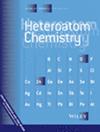Cu(II) complex of phenylthiosemicarbazone: An in situ catalyst for formation of C-N bond between different N-based neucleophiles with arylboronic acids at room temperature
IF 1.4
4区 化学
Q3 CHEMISTRY, MULTIDISCIPLINARY
引用次数: 3
Abstract
We have reported here a new synthetic protocol for the formation of C-N bond catalyzed by a thiosemicarbazone complex of copper. This in situ complex has been found to be very effective for Chan-Lam C-N cross-coupling reaction of anilines and various imidazoles at room temperature. Pyrazole and 4-bromoindole were also activated for C-N bond formation by using this protocol at room temperature. This catalytic system gave good-to-excellent yield using a mixture of DMF and water as solvent in a 1:1 proportion.
苯基硫代氨基脲Cu(II)配合物:室温下不同n基亲核试剂与芳基硼酸之间形成C-N键的原位催化剂
本文报道了一种新的铜硫代氨基脲配合物催化形成C-N键的合成方法。这种原位配合物在室温下对苯胺和各种咪唑的Chan-Lam C-N交叉偶联反应非常有效。在室温下,吡唑和4-溴吲哚也被活化成C-N键。该催化体系使用DMF和水的混合物作为溶剂,以1:1的比例得到了良好到优异的收率。
本文章由计算机程序翻译,如有差异,请以英文原文为准。
求助全文
约1分钟内获得全文
求助全文
来源期刊

Heteroatom Chemistry
化学-化学综合
CiteScore
1.20
自引率
0.00%
发文量
5
审稿时长
6 months
期刊介绍:
Heteroatom Chemistry brings together a broad, interdisciplinary group of chemists who work with compounds containing main-group elements of groups 13 through 17 of the Periodic Table, and certain other related elements. The fundamental reactivity under investigation should, in all cases, be concentrated about the heteroatoms. It does not matter whether the compounds being studied are acyclic or cyclic; saturated or unsaturated; monomeric, polymeric or solid state in nature; inorganic, organic, or naturally occurring, so long as the heteroatom is playing an essential role. Computational, experimental, and combined studies are equally welcome.
Subject areas include (but are by no means limited to):
-Reactivity about heteroatoms for accessing new products or synthetic pathways
-Unusual valency main-group element compounds and their properties
-Highly strained (e.g. bridged) main-group element compounds and their properties
-Photochemical or thermal cleavage of heteroatom bonds and the resulting reactivity
-Uncommon and structurally interesting heteroatom-containing species (including those containing multiple bonds and catenation)
-Stereochemistry of compounds due to the presence of heteroatoms
-Neighboring group effects of heteroatoms on the properties of compounds
-Main-group element compounds as analogues of transition metal compounds
-Variations and new results from established and named reactions (including Wittig, Kabachnik–Fields, Pudovik, Arbuzov, Hirao, and Mitsunobu)
-Catalysis and green syntheses enabled by heteroatoms and their chemistry
-Applications of compounds where the heteroatom plays a critical role.
In addition to original research articles on heteroatom chemistry, the journal welcomes focused review articles that examine the state of the art, identify emerging trends, and suggest future directions for developing fields.
 求助内容:
求助内容: 应助结果提醒方式:
应助结果提醒方式:


